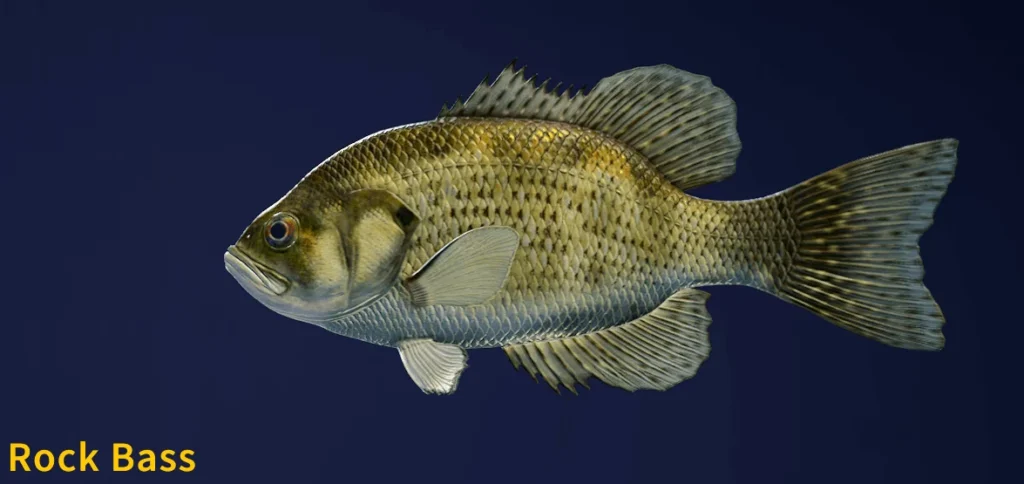Description
The Rock Bass, also known as the Rock Perch and Red Eye, is a freshwater fish native to North America. They are similar in appearance to the Smallmouth Bass, however are typically significantly smaller. The average Rock Bass is around 6-10″ (15-25cm) long, and rarely weigh over 1lb (0.4kg). Rock Bass can live to be around 12 years old. They prefer clear, rocky, and vegetated stream pools and lake margins.
― In-game description
This is the Wiki page for the Rock Bass found in Golden Ridge Reserve.
Summary
Habitats
Rock Bass can be found in Shallow Pond, Deep Pond, Lake Shore, Upriver, Middle River, and River Mouth.
Bait & Lure Preferences
Lake Mix (100%), Minnow (100%), Spinner - Constant (100%), Tube - Jigging (100%), Tube - Twitching (100%), Bloodworm (38%), Eggs (38%), Spinnerbait - Constant (38%), Spinnerbait - Stop and Go (38%), Spinnerbait - Twitching (38%), Bread (13%), Cheese (13%), Crankbait - Constant (13%), Crankbait - Twitching (13%), Frog - Twitching (13%), Grub - Constant (13%), Grub - Jigging (13%), Grub - Twitching (13%), Hotdog (13%), Leeches (13%), Marshmallow (13%), Popper - Twitching (13%) and Spoon - Constant (13%) can be used to lure and catch Rock Bass in COTW the Angler. The percentages indicate the preference level for a specific bait or lure, where 100% is most prefered.
Traits
The Rock Bass has the following traits:
- Aggressive:
Goes directly for a strike without nibbling.
- Hard Fighter:
Tries its best to get off the hook.
Tips for catching Rock Bass
Preferred Bait
The Rock Bass preferes Minnow as bait. If you use Minnow you have the best chance of catching a Rock Bass.
Time of Day
The best time for catching a Rock Bass is during ☀️Daytime and 🌙Nighttime.
Water Temperature
Rock Bass will bite when the water temperature is between 10.0°C and 20.0°C, with an ideal temperature of 15.0°C.
Ranks & Hook Sizes
| Rank | Hook Size |
|---|---|
| 👶Juvenile (0.0500-0.1000kg) | 10 |
| 🥉Bronze (0.1000-0.4000kg) | 9 |
| 🥈Silver (0.4000-0.7000kg) | 8 |
| 🥇Gold (0.7000-1kg) | 7 |
| 💎Diamond (1-1.4000kg) | 6 |
Rock Bass Hotspots Map
A map with known hotspots for Rock Bass. These are locations where Diamond Rock Bass have been caugth, but they don't guarantee a Diamond Rank catch. Also, other ranks of Rock Bass can be caught at these locations.

Trivia
The Rock Bass: A Freshwater Gem
The Rock Bass (Ambloplites rupestris), also known as the rock perch, goggle-eye, red eye, and black perch, is a captivating species of freshwater fish native to east-central North America. This species belongs to the sunfish family (Centrarchidae) and is well-known for its distinctive red eyes and robust body.
Physical Characteristics
Rock bass are medium-sized fish, typically measuring between 15 and 25 centimetres (6 and 10 inches) in length, though they can grow up to 43 centimetres (17 inches) and weigh as much as 1.4 kilograms (3.1 pounds). They have a unique appearance with two dorsal fins, one spiny and the other soft-rayed, and six spines in their anal fin, which sets them apart from other sunfish species. Their body colour ranges from golden brown to olive, with a white to silver belly, and they possess the remarkable ability to change colour to blend with their surroundings.
The red eyes of the Rock Bass are perhaps its most striking feature. These eyes not only give the fish its nickname, “red eye,” but also provide excellent vision, allowing it to hunt effectively in various light conditions. The body of the Rock Bass is laterally compressed, making it well-suited for navigating through rocky and vegetated environments.
Habitat and Distribution
These adaptable fish thrive in clear, rocky, and vegetated stream pools and lake margins. They are commonly found along rocky shorelines and can often be seen near human activity, such as under lakeside docks and near swimming areas. The Rock Bass is native to the St. Lawrence River and Great Lakes system, the upper and middle Mississippi River basin, and extends from Québec to Saskatchewan in the north, down to Missouri and Arkansas, and throughout the eastern U.S. to northern Alabama, Georgia, and Florida.
Rock bass prefer habitats with plenty of cover, such as submerged logs, rocks, and vegetation. These environments provide shelter from predators and abundant food sources. They are also known to inhabit slow-moving rivers and streams, where they can find ample prey and suitable nesting sites.
Diet and Behaviour
Rock bass are opportunistic feeders with a diet that includes insects, crustaceans, and smaller fish. Their large mouths and small conical teeth are well-suited for catching a variety of prey. They are often found in groups, particularly near other sunfish, and are known for their resilience and adaptability to different environments.
Their feeding habits can vary depending on the availability of food sources. Insects such as mayflies, caddisflies, and dragonflies are common prey, especially during their larval stages. Rock bass also consume crayfish, which are abundant in their preferred habitats. Small fish, including minnows and juvenile sunfish, are also part of their diet.
Rock bass are known for their aggressive behaviour, especially when defending their territory or during the breeding season. They are highly territorial and will chase away intruders, including other fish and even larger predators. This aggressive nature makes them a popular target for anglers, who enjoy the challenge of catching these feisty fish.
Reproduction and Lifespan
The breeding season for rock bass occurs in late spring to early summer when water temperatures rise. Males create nests in shallow waters, where females lay their eggs. The males then guard the nests until the eggs hatch. Rock bass can live up to 10 years, although few reach this age in the wild.
During the breeding season, male rock bass become more colourful, with their body colours intensifying to attract females. They construct nests by fanning their fins to clear away debris and create a shallow depression in the substrate. Females are attracted to these nests and lay their eggs, which the males fertilize externally.
The males are highly protective of the nests and will aggressively defend them from potential threats. This parental care ensures a higher survival rate for the eggs and fry. Once the eggs hatch, the fry remain in the nest for a few days before dispersing to find their own food and shelter.
Fishing and Conservation
Rock bass are popular among anglers due to their aggressive nature and the challenge they present when caught. They are not considered endangered and have a conservation status of “Least Concern” according to the IUCN. Their populations are stable, and they continue to thrive in their native habitats as well as in areas where they have been introduced.
Anglers often target rock bass using a variety of fishing techniques, including fly fishing, spinning, and baitcasting. Live bait such as worms, minnows, and crayfish are effective, as well as artificial lures that mimic their natural prey. Rock bass are known for their strong fight when hooked, making them a rewarding catch for both novice and experienced anglers.
In terms of conservation, rock bass populations are generally healthy, but it is important to monitor their numbers and habitat conditions to ensure their continued success. Habitat degradation, pollution, and overfishing can pose threats to their populations, so responsible fishing practices and habitat conservation efforts are essential.
Ecological Importance
Rock bass play a significant role in the freshwater ecosystems they inhabit. As both predators and prey, they help maintain the balance of aquatic food webs. Their diet of insects, crustaceans, and small fish helps control the populations of these organisms, preventing overpopulation and ensuring a healthy ecosystem.
In turn, rock bass serve as a food source for larger predators, including larger fish, birds, and mammals. Their presence in the ecosystem supports the biodiversity and overall health of freshwater habitats.
Cultural Significance
In addition to their ecological importance, rock bass hold cultural significance for many communities. They are a popular target for recreational fishing, providing opportunities for outdoor activities and contributing to local economies. Fishing for rock bass is a cherished pastime for many anglers, who appreciate the challenge and excitement of catching these spirited fish.
Rock bass are also featured in various educational programs and initiatives aimed at promoting conservation and environmental awareness. By learning about the biology and ecology of rock bass, individuals can gain a greater appreciation for freshwater ecosystems and the importance of preserving them.
Conclusion
The Rock Bass is a resilient and adaptable species that plays a significant role in the freshwater ecosystems of North America. Whether you’re an angler or a nature enthusiast, the Rock Bass is a species worth appreciating for its unique characteristics and ecological importance. From their striking red eyes to their aggressive behaviour and important role in the food web, Rock Bass are truly a freshwater gem.
